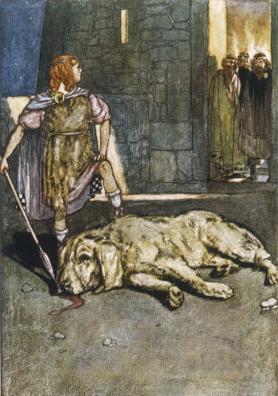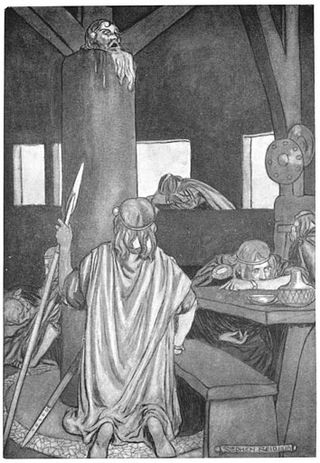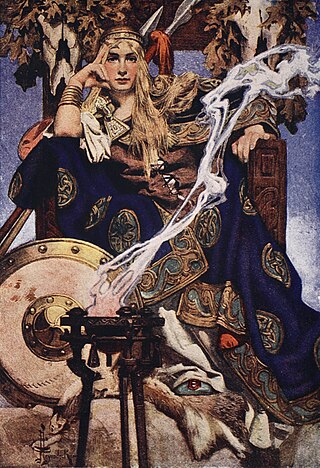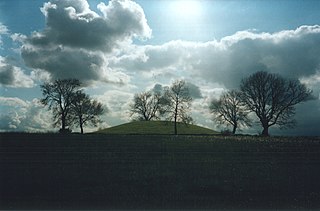Related Research Articles

The Morrígan or Mórrígan or Danu, also known as Morrígu, is a figure from Irish mythology. The name is Mór-ríoghan in modern Irish before the spelling reform, and it has been translated as "great queen" or "phantom queen".

Macha was a sovereignty goddess of ancient Ireland associated with the province of Ulster, particularly the sites of Navan Fort and Armagh, which are named after her. Several figures called Macha appear in Irish mythology and folklore, all believed to derive from the same goddess. She is said to be one of three sisters known as 'the three Morrígna'. Like other sovereignty goddesses, Macha is associated with the land, fertility, kingship, war and horses.
Conall Cernach is a hero of the Ulaid in the Ulster Cycle of Irish mythology. He had a crooked neck and is said to have always slept with the head of a Connachtman under his knee. His epithet is normally translated as "victorious" or "triumphant", although it is an obscure word, and some texts struggle to explain it. Alternative meanings include "angular, having corners", "swollen", or "possessing a dish or receptacle". The original form of the name "Conall" in Ogham inscriptions was Cunavalas.

Deirdre is a tragic heroine in the Ulster Cycle of Irish mythology. She is also known by the epithet "Deirdre of the Sorrows".

Conchobarmac Nessa is the king of Ulster in the Ulster Cycle of Irish mythology. He rules from Emain Macha. He is usually said to be the son of the High King Fachtna Fáthach, although in some stories his father is the druid Cathbad, and he is usually known by his matronymic, mac Nessa: his mother is Ness, daughter of Eochaid Sálbuide, King of Ulster.

Cú Chulainn, is an Irish warrior hero and demigod in the Ulster Cycle of Irish mythology, as well as in Scottish and Manx folklore. He is believed to be an incarnation of the Irish god Lugh, who is also his father. His mother is the mortal Deichtine, sister of king Conchobar mac Nessa.
In Irish mythology, Deichtine or Deichtire was the sister of Conchobar mac Nessa and the mother of Cú Chulainn. Her husband was Sualtam, but Cú Chulainn's real father may have been Lugh of the Tuatha Dé Danann.

Súaltammac Róich is the mortal father of the hero Cúchulainn in the Ulster Cycle of Irish mythology. His wife is Deichtine, sister of Conchobar mac Nessa, king of Ulster. His brother is Fergus mac Róich.

Fergus mac Róich/Róigh is an Irish hero and a character in the Ulster Cycle of Irish mythology. Formerly the king of Ulster, he is tricked out of the kingship and betrayed by Conchobar mac Nessa, becomes the ally and lover of Conchobar's enemy, queen Medb of Connacht, and joins her expedition against Ulster in the Táin Bó Cúailnge. Fergus is described as being of huge size and sexual potency. This leads him into many a precarious situation as in the story of the Táin Bó Flidhais.

Medb, later spelled Meadhbh, Méabh(a) and Méibh, and often anglicised as Maeve, is queen of Connacht in the Ulster Cycle of Irish mythology. Her husband in the core stories of the cycle is Ailill mac Máta, although she had several husbands before him who were also kings of Connacht. She rules from Cruachan. She is the enemy of Conchobar mac Nessa, king of Ulster, and is best known for starting the Táin Bó Cúailnge to steal Ulster's prize stud bull Donn Cúailnge.

Táin Bó Cúailnge, commonly known as The Táin or less commonly as The Cattle Raid of Cooley, is an epic from Irish mythology. It is often called "the Irish Iliad", although like most other early Irish literature, the Táin is written in prosimetrum, i.e. prose with periodic additions of verse composed by the characters. The Táin tells of a war against Ulster by Queen Medb of Connacht and her husband King Ailill, who intend to steal the stud bull Donn Cuailnge. Due to a curse upon the king and warriors of Ulster, the invaders are opposed only by the young demigod, Cú Chulainn.

The Ulster Cycle, formerly known as the Red Branch Cycle, is a body of medieval Irish heroic legends and sagas of the Ulaid. It is set far in the past, in what is now eastern Ulster and northern Leinster, particularly counties Armagh, Down and Louth. It focuses on the mythical Ulster king Conchobar mac Nessa and his court at Emain Macha, the hero Cú Chulainn, and their conflict with the Connachta and queen Medb. The longest and most important tale is the epic Táin Bó Cúailnge. The Ulster Cycle is one of the four 'cycles' of Irish mythology and legend, along with the Mythological Cycle, the Fianna Cycle and the Kings' Cycle.

Navan Fort is an ancient ceremonial monument near Armagh, Northern Ireland. According to tradition it was one of the great royal sites of pre-Christian Gaelic Ireland and the capital of the Ulaidh. It is a large circular hilltop enclosure—marked by a bank and ditch—inside which is a circular mound and the remains of a ring barrow. Archeological investigations show that there were once buildings on the site, including a huge roundhouse-like structure that has been likened to a temple. In a ritual act, this timber structure was filled with stones, deliberately burnt down and then covered with earth to create the mound which stands today. It is believed that Navan was a pagan ceremonial site and was regarded as a sacred space. It features prominently in Irish mythology, especially in the tales of the Ulster Cycle. According to the Oxford Dictionary of Celtic Mythology, "the [Eamhain Mhacha] of myth and legend is a far grander and mysterious place than archeological excavation supports".
Athirne Ailgheasach, son of Ferchertne, is a poet and satirist of the court of Conchobar mac Nessa in the Ulster Cycle of Irish mythology, who abuses the privileges of poets.

In the Ulster Cycle of Irish mythology Donn Cúailnge, the Brown Bull of Cooley, was an extremely fertile stud bull over whom the Táin Bó Cúailnge was fought.
Mugain, daughter of Eochaid Feidlech,, is a legendary queen in the Ulster Cycle of Irish mythology; characterized as the "Strumpet wife of Conchobar mac Nessa", the king of Ulster. Also styled Mumain, she had a son with him named Glaisne. She was also a sister of Medb by paternity.
Cúscraid known by the epithet Mend Macha, is a son of Conchobar mac Nessa in the Ulster Cycle of Irish mythology.

Liath Macha and Dub Sainglend are the two chariot-horses of Cúchulainn in the Ulster Cycle of Irish mythology.
Fedelm is a female prophet and fili, or learned poet, in the Ulster Cycle of Irish mythology. She appears in the great epic Táin Bó Cuailnge, in which she foretells the armies of Medb and Ailill mac Máta will face against the Ulaid and their greatest champion, Cú Chulainn. A prophetess of the same name appears in another tale, which associates her with Cú Chulainn.
The Curadmír, modern Curadhmhír was an ancient custom referred to in early Irish literature, whereby the warrior acknowledged as the bravest present at a feast was given precedence and awarded the choicest cut of meat. This was often disputed violently. The custom appears most often in the legends of the Ulster Cycle. It is parallelled by historical customs of the ancient Celts of continental Europe, as recorded by classical writers.
References
- ↑ James Mackillop, Dictionary of Celtic Mythology, 1998, p. 101
- ↑ "The Debility of the Ulstermen" Archived 2013-12-26 at the Wayback Machine at Celtic Literature Collective